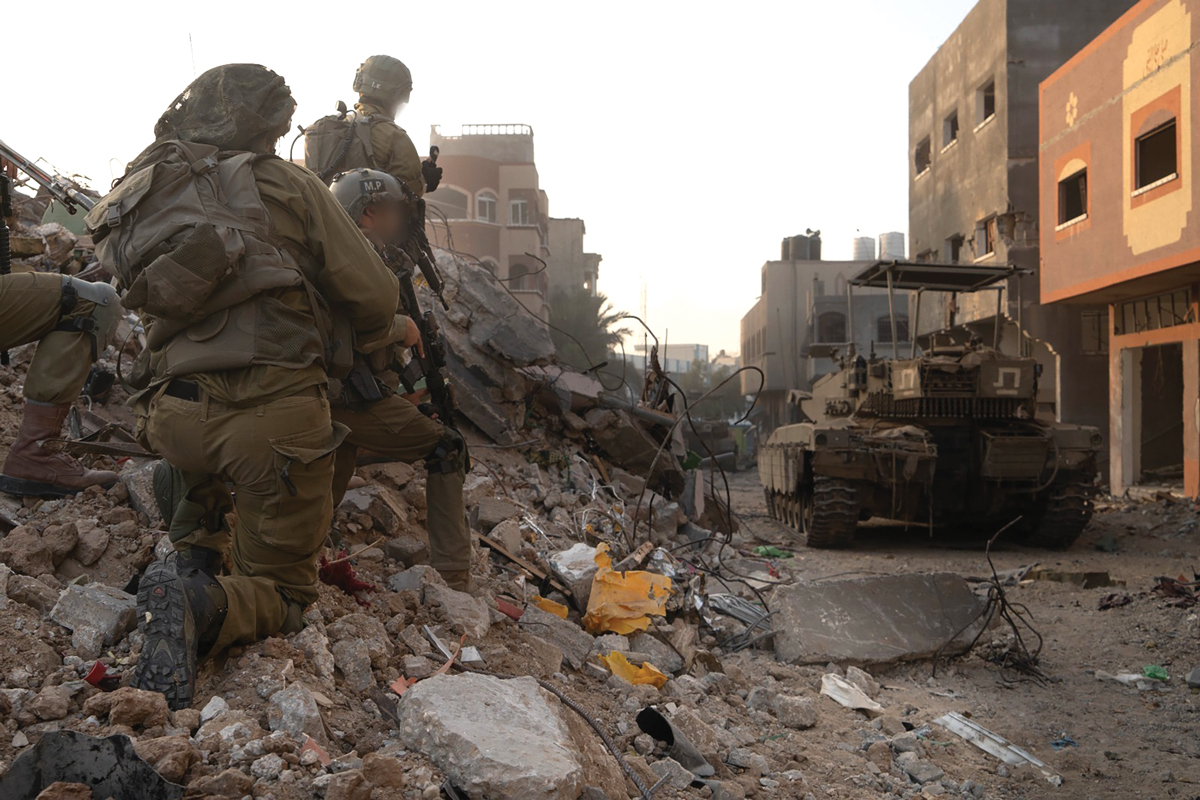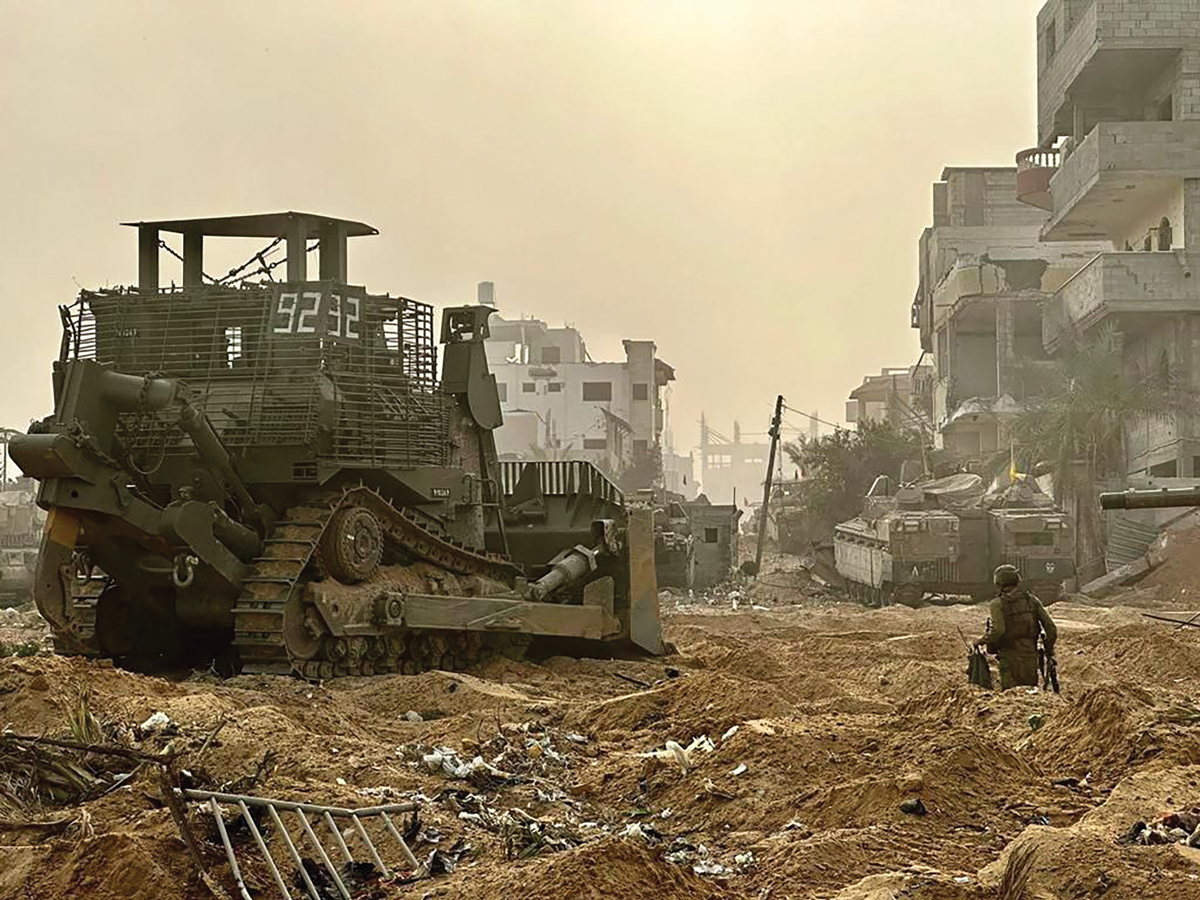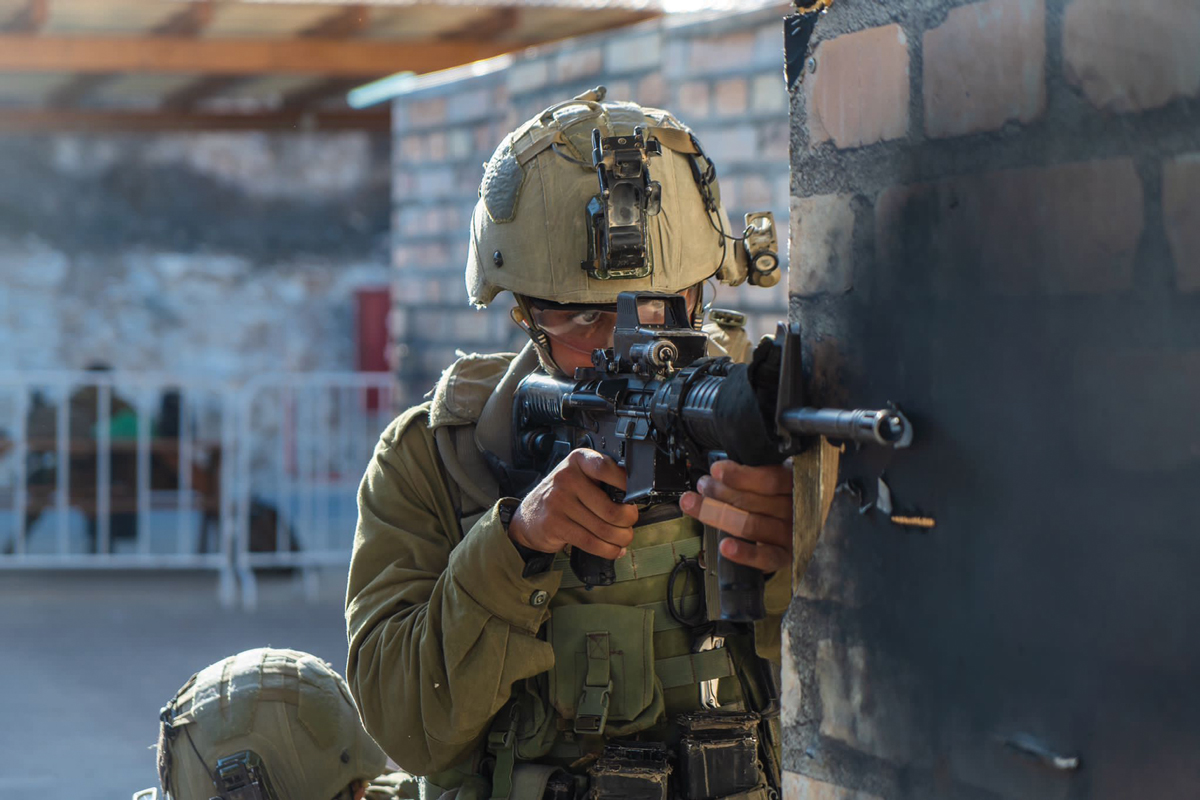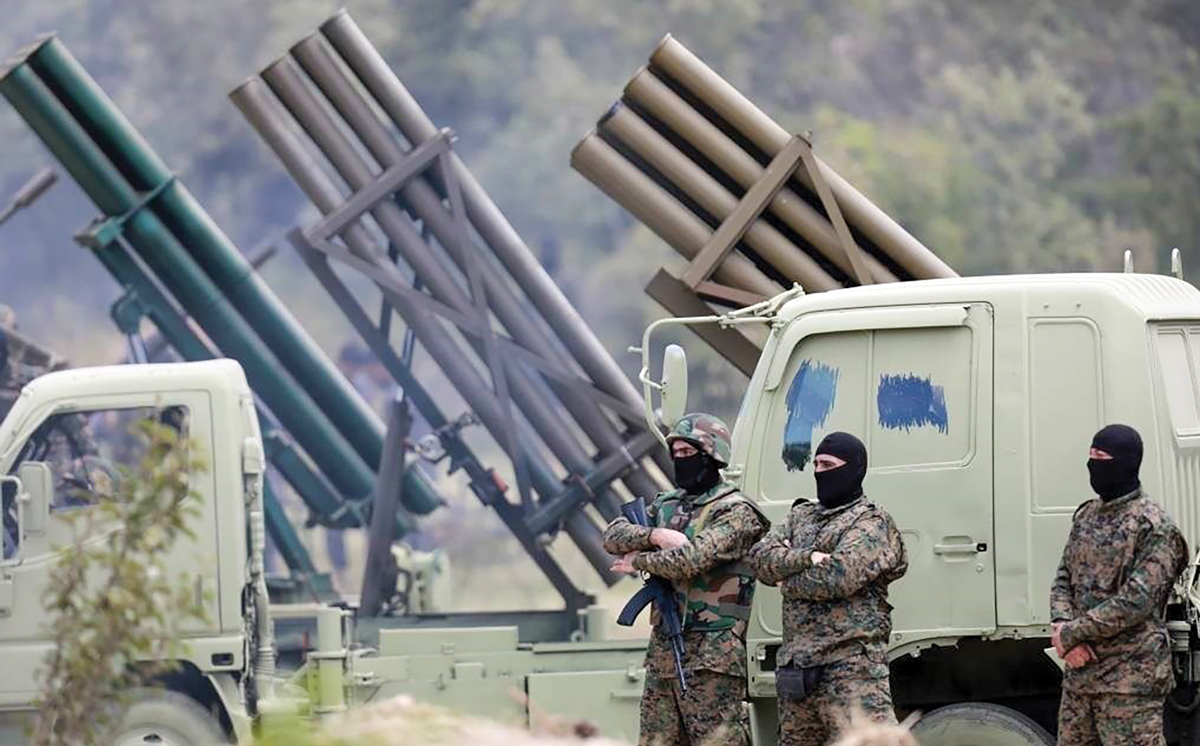The End of the Deterrence Strategy in Gaza
Dr. Omer Dostri

Editor’s note: The views expressed in this article are those of the author and do not reflect the views of the U.S. Army, Department of Defense, or any other agency of the U.S. government.
On Saturday, 7 October 2023, a horrific and well-planned attack reminiscent of al-Qaeda’s attack on 9/11 on the United States was executed by Hamas against Jewish settlements in southern Israel.1 This terrorist attack is expected to have far-reaching consequences for the region and for the threat landscape of the State of Israel. Tragically, the results of this attack have led to the loss of more than 1,200 Israeli lives and left thousands more injured, including elderly, infants, toddlers, and many innocent citizens (among them Americans).2 Around 240 Israelis and foreign nationals, including Americans, were abducted and taken into the Gaza Strip.3 This devastating event marked one of the deadliest attacks on Jewish people since the Holocaust.4
The planning of this terror campaign had been underway for at least two years, involving psychological warfare and a web of long-term deception to blindside Israel.5 It was executed with a high degree of military organization and professionalism, resembling the tactics of a regular army’s special forces rather than those of a typical terrorist organization.
In the early hours of 7 October, Hamas launched thousands of rockets at Israel while many Israeli officers and soldiers were on leave due to a holiday and Shabbat occurring simultaneously.6 Hamas’s special forces (known as the Nukhba) deployed squadrons of drones equipped with explosive charges and drones equipped with grenades, which targeted guard posts and Israel Defense Forces (IDF) surveillance, control, communication, and weapons systems near the border.7 Following this, thousands of Hamas terrorists, divided into teams with specific attack plans, gathered near the Israeli border.8 They managed to breach the border at multiple locations using explosive devices, infiltrate Israeli territory, and open the way for thousands more terrorists on motorcycles and dozens of Islamic State (IS)-style vans loaded with various weaponry, including rifles, machine guns, antitank launchers with advanced technology, rockets, explosive devices, and a substantial number of hand grenades.9 In addition, some Hamas terrorists infiltrated Israel by air, using parachutes for aerial insertion. In total, about three thousand terrorists infiltrated Israel that morning.10
Each Hamas team had a distinct mission. Some aimed to seize control of military installations, while others were assigned the grisly task of perpetrating massacres in settlements. These teams were further subdivided, with the primary terrorist force responsible for capturing settlements and military bases, and targeting civilians and soldiers. Accompanying them were teams tasked with securing entry and exit points to these locations, hindering potential assistance from the IDF to civilians.11
In a daring operation, hundreds of terrorists infiltrated several IDF bases and posts, even taking control of the IDF’s Gaza Division headquarters.12 At these sites, they systematically dismantled communication, observation, and surveillance equipment with the intention of disrupting the IDF’s command-and-control capabilities. Hamas’s strategic and tactical surprise effectively blinded the IDF, impairing its capacity to respond swiftly and efficiently, and sowing widespread civil, military, and political disorder.13
This heinous attack was the work of a terrorist organization, yet it displayed an exceptional military and professional approach akin to the methods employed by special forces in regular armies. This underscores the significant military and intelligence capabilities that Hamas had meticulously developed over the years, specifically in preparation for this devastating event. Hamas leveraged these capabilities for IS-style acts of terrorism, including massacres of innocent civilians and unprepared soldiers that involved brutal actions such as beheadings, immolation of the elderly and infants, setting entire homes ablaze with their occupants inside, torture, amputations, rapes, and numerous other atrocities.14
Hamas had early intelligence regarding an outdoor concert attended by thousands of young people near the same settlements it infiltrated. Hundreds of terrorists raided the place and murdered (and even burned alive) hundreds of Israelis who had come to celebrate and rejoice.15 In one day, Hamas managed to cause damage and losses to Israel (over 1,200 death toll) equal to almost half of the losses during the entire Yom Kippur War (2,689 death toll).
Israel was completely surprised by the attack, as no advance intelligence had been received. It was a significant military strategic and tactical failure in intelligence for the IDF and the Israeli security apparatus. While the IDF and the Israel Security Agency (ISA, or commonly known as Shin Bet) had received some intelligence messages regarding an upcoming event on the night of 6 October, the prevailing assumption was that it might involve rocket launches or the infiltration of a small terrorist squad attempting to breach the fence.16 There was no indication in the intelligence reports of a large-scale terrorist attack of this magnitude.17 Israeli intelligence had not been privy to the grand plan Hamas had been meticulously devising—a major omission given the scope of the attack and the sheer number of terrorists involved.
Israel’s Counterterrorism Immediate Response
The initial and immediate Israeli reactions to the terror attack were initiated by civilian residents, many of whom were officers and security personnel in the settlements. They swiftly armed themselves with small firearms and ventured out to protect the settlements from the terrorists who were inflicting widespread carnage and destruction. The second wave of response was launched by law enforcement officers and counterterrorism units from the police and the IDF. These units included YAMAM (Israel’s national counterterrorism unit), Shaldag (the air force reconnaissance unit), Magellan (paratroopers reconnaissance unit), Sayeret Matkal (general staff reconnaissance unit), Shayetet 13 (the elite naval commando unit), the IDF’s “Ghost” and counterterrorism units, border police, and various others.
Simultaneously, the IDF initiated helicopter strikes within Israeli territory against the terrorists. Special forces engaged in negotiations and attempted to prevent numerous kidnapping and hostage incidents across various areas, including a police station in Sderot (which was ultimately destroyed by Israeli police forces). Only after several hours did additional Israeli forces reach the region and gradually regain control over the territories. Nonetheless, several days later, Hamas terrorist squads were discovered within the settlements, and it took approximately a week for Israel’s security forces to fully reestablish control over the area following Hamas’s raid.
At the same time, following hours of combat within the settlement areas, the Israeli air force initiated a series of increasingly intense attacks on the Gaza Strip. These strikes were aimed at command-and-control centers, residences of known terrorists, communication and surveillance facilities, the annihilation of rocket-launching squads, ammunition storage sites, training camps, terrorist strongholds, targeting senior terrorists and the organization’s leadership, among other objectives.18 On 13 October, the IDF issued a warning to the northern and central Gaza populations, urging them to relocate to the south in anticipation of intensified airstrikes against tunnels and bunkers, and the potential ground entry of Israeli forces into Gaza.19
The Road to the October 2023 Attack—The Collapse of Israel’s Deterrence Strategy
Israel’s colossal and historic failure was not limited only to the intelligence and operational sphere. Thus, Israel has completely failed in its political perception as well. Since Hamas assumed control of the Gaza Strip in June 2007, Israel has pursued a strategy of deterrence in its dealings with the terrorist organization. The foundation of this approach was rooted in a political miscalculation within Israel and was shared by successive governments since 2007.20 This miscalculation regarded Hamas as the Gaza Strip’s de facto ruler, a known and somewhat predictable adversary conscious of Israel’s capabilities and deterred from Israel at different levels over the years. The belief was that it might be possible to engage in discussions and reach understandings, however indirectly, with Hamas for the sake of shared interests such as stability and economic prosperity in the Gaza Strip.

The notion that economic and social development and prosperity would lead to security stability and the prevention of conflict in Gaza inadvertently led to a disregard for the fundamentalist religious dimension of Hamas as an extreme Islamic terrorist organization openly committed to destroying the State of Israel. In this context, Israeli political and military leadership viewed the behavior of this IS-style organization through Western and “rational” lenses, temporarily losing sight of the true nature of the enemy they were confronting.
On the political front, the possibility of defeating Hamas was maintained, and there were military attack plans prepared for this purpose.21 However, this possibility was never regarded as a serious course of action; instead, it was primarily used as a bargaining tool to sustain deterrence against Hamas. Despite approximately eight significant military operations in the Gaza Strip between 2008 and the present, the political leadership in Israel remained steadfast in its approach, and the deterrence strategy persisted despite repeated failures.
Starting in March 2018, Hamas adopted a strategy of operating against Israel within what is often referred to as the “gray zone.” This approach primarily employed seemingly civilian methods coupled with low-level military tactics. Hamas aimed to continue its conflict with Israel while avoiding a substantial Israeli response.22 Israel’s response to this gray-zone strategy was also within the framework of the deterrence strategy. Furthermore, in recent years, Israel made a deliberate effort to target only the Palestinian Islamic Jihad in military operations to keep Hamas uninvolved and deter it from entering the fray.23
In line with Russia’s two-decade-long policy of managing the gray zone, particularly in its interactions with Ukraine, it became apparent that Hamas’s gray-zone policy was designed to confuse Israel and obscure Hamas’s preparations for nonconventional attacks (in the Russian context, it was a conventional one).24 Ultimately, the Israeli deterrence strategy crumbled completely, and it can be said that it disintegrated, especially in the face of the most severe security event ever experienced by the State of Israel and one of the most serious events in the history of the Jewish people. This event will reshape the entire region.
From Deterrence to Military Decision—Israel’s Options for Dealing with the Gaza Strip
National policy in Gaza. The State of Israel is confronted with several policy and political strategy options for the Gaza Strip following the IDF’s defeat of Hamas and other terrorist organizations, along with occupation of the territory.
Installed local Gazan administration. Israel could opt to withdraw from the Gaza Strip after the IDF gained complete military control, eliminating tunnels, weapons, military infrastructure, and the terrorist leadership. The IDF’s military control is expected to continue for several months to up to two years. After the departure of the IDF, the Gazan residents would be allowed to determine their leadership and future, potentially paving the way for a local administration that is not affiliated with any terrorist organization nor with the Palestinian Authority. Under this scenario, it is conceivable to partition the Gaza Strip into four distinct self-governing regions, each presided over by a prominent tribal authority.

Under these circumstances, it is logical to anticipate that either the central government would be too feeble to secure popular support, or Gaza would be mired in turmoil due to conflicts between clans and autonomous regions. Such a scenario might create a governance vacuum, opening the door for extremist factions to enter, allowing terrorist organizations to gain strength over time.
Palestinian Authority administration in Gaza. After temporary military control of Israel for months to two years, Israel will permit the Palestinian Authority to enter Gaza and set up a self-governing, decentralized autonomous system without the option of creating a military force. However, the transfer of control of Gaza to the Palestinian Authority could potentially lead to a loss of power to radical Islamists upon their resurgence. This is attributed to the inherent weaknesses of the Palestinian Authority and its significant corruption.
Since 1993, the Palestinian Authority’s governance of the territory has exposed notable political and security deficiencies. On the political front, it has faltered in its efforts to create a functional state entity, grappling with problems related to corruption and administrative inefficiency.25 From a security perspective, the Palestinian Authority has struggled for the last thirty years to govern effectively in the territories of Judea and Samaria. Without the presence of Israeli security forces, it is likely that the Palestinian Authority’s rule in Areas A and B in Judea and Samaria might have collapsed, potentially allowing Hamas to assume control of the region. The Palestinian Authority already collapsed in Gaza in 2007 when Hamas took control. Moreover, even before Hamas assumed control of Gaza, during the Palestinian Authority’s rule, Israel faced rocket attacks and ongoing incursions by terrorists into military installations and settlements.26
In addition to these factors, there is the institutional framework of antisemitic incitement directed at Israel, Jews, and the Israeli population, as well as the institutional measures that the Palestinian Authority undertakes to incentivize acts of terrorism against Israel. This includes the horrific “pay-for-slay” policy, where the Palestinian Authority provides payments to the families of individuals involved in attacks against Jews.27
Given the civil and security struggles of the Palestinian Authority in the territories of Gaza, Judea, and Samaria, and its encouraging of institutional terrorism, the return of its control over the Gaza Strip is unlikely to improve Israel’s security situation. Instead, it might provide a fertile ground for future acts of terrorism and violence against Jewish citizens in Israel.
International or regional mandate in Gaza. An alternative approach involves prearranging an international mandate, in cooperation with the UN, Western European nations, and the United States, for the civilian administration of Gaza City. A drawback in such a scenario lies in the inherent weaknesses of peacekeeping forces and the UN Interim Force. Over the years, numerous instances of UN peace enforcement missions failing have been observed, including in regions like Syria, Lebanon, and Egypt.28 These forces have either been compelled to retreat in the face of terrorist organizations and jihadists or have displayed their vulnerability, hesitating to enforce the mandates entrusted to them for maintaining peace and stability. Therefore, it is reasonable to anticipate similar outcomes if peacekeeping forces are deployed in Gaza. It is highly likely that these forces will soon find themselves unable to protect Israel from terrorist organizations and individuals.

Another option is that Israel and the United States might propose that the United Arab Emirates, Bahrain, or Saudi Arabia assume civilian control over the Gaza Strip, with these Gulf states managing its economic and civil aspects. Meanwhile, either Israel or U.S. forces would maintain a military presence in the area to oversee security concerns. In this scenario, it remains uncertain how well the coordination between the civil administration of the Gulf states and Israeli or American security oversight will be, especially in terms of cooperation, synchronization, and overall effectiveness.
Israeli long-term military administration. A fourth option involves setting up a military government in the Gaza Strip with an indefinite timeline, aimed at nurturing a central local leadership or partitioning the territory into self-governing districts with distinct leadership in each district.
From a security perspective, the optimal choice for Israel is to occupy the Gaza Strip and establish a lasting military presence. This approach would enable Israel to prevent the resurgence of new terrorist organizations, maintain a permanent intelligence foothold in the region, and curb institutionalized incitement against Israel and the Jewish people throughout Gaza, like the political and security situation before the first Oslo Accords in 1993 when control shifted to the Palestinian Authority.29
Regardless of the chosen option, Israel probably would need to establish substantial buffer zones spanning several kilometers to provide strategic depth and enable swift responses to potential future terrorist incursions. According to some of the Israeli public, including members of the Knesset, public figures, journalists, and nongovernmental organizations, these buffer zones should complement the creation of new Israeli settlements on land previously occupied by terrorists along the border with Israel, reinstating the political situation as it stood before the disengagement plan in August 2005 that led to the relocation of Jewish settlements and the establishment of Hamas terrorist bases.30
The perspective that forms the foundation for those advocating the establishment of Israeli settlements in Gaza is that seizing and securing land constitutes a more substantial blow to radical Islamist terror groups than the elimination of terrorist operatives and high-ranking leaders, surpasses the destruction of buildings and infrastructure, and holds more weight than capturing prisoners. It is seen as the most deterrence means and a clear victory for Israel. To them, a robust ground campaign in the Gaza Strip, encompassing the occupation of territories, the creation of new Israeli settlements, and the voluntary relocation of hundreds of thousands of Palestinians to Egypt with no option for return will greatly fortify Israeli deterrence and project influence throughout the entire Middle East.
Military strategy in Gaza. To implement the political leadership’s strategy of defeating Hamas, the IDF will need to embark on a comprehensive and synchronized military operation with the aim of occupying the Gaza Strip. Israel’s military strategy in Gaza comprises two primary phases: an aerial campaign and a ground operation.
Aerial campaign. Following the initiation of the terrorist attack by Hamas on 7 October, the IDF air force promptly commenced attacking terror targets within the Gaza Strip. As the days passed, the intensity of these air strikes increased, involving hundreds of targets associated with terrorist organizations. In the initial twenty days of the conflict, Israeli forces had already deployed over eight thousand munitions into Gaza. The aerial campaign serves two primary objectives. The first goal is to eliminate terrorists and disrupt critical terrorist infrastructure, including rocket and ammunition depots, weapons manufacturing facilities, terrorist homes, communication and intelligence systems, headquarters, and the destruction of terrorist tunnels. The second goal is to pave the way for the ground incursion of infantry, armored units, tanks, artillery, and engineering forces within the Gaza Strip.
Ground operation. The ground offensive, which began cautiously on 26 October with limited assault raids in the initial two days, is characterized by a gradual, controlled, and meticulous approach. The overarching strategy is to partition the Gaza Strip into four main sectors: the north, center-north, center-south, and south. At each stage of this operation, the IDF’s objectives are to secure and establish control over open and agricultural areas before advancing slowly and carefully into the densely populated urban zones, where intense combat is expected. This approach entails an approximate daily advance of one kilometer per day across and along the Gaza Strip. The IDF’s tactic involves isolating and consolidating control over each area before moving on to the next. This method likely necessitates two to three months of ground maneuvers within Gaza.
The first phase, which is the ongoing phase at the time of this writing, focuses on the northern part of the Gaza Strip, primarily cities like Beit Lahia, Beit Hanoun, Jabalia, and Gaza City. In this stage, the IDF aims to encircle the entire northern Gaza region from various directions. The second phase will involve encircling and surrounding the city of Deir al-Balah in the center-north Gaza Strip while deploying forces from both the north (west along the coast and east in adjacent open areas near Israel) and the central Israeli border. The third phase will center on the Khan Yunis area in the center-south, and the fourth phase will concentrate on the Rafah area in the south near the border with Egypt.
Realization of the multidomain campaign. The ground operation includes the use of infantry, tanks, armor, artillery, engineering, and special forces from the IDF, police, and ISA. However, the initial phase of the air and sea offensive is not separate from the subsequent ground campaign in Gaza; rather, it is designed to complement and bolster the ground campaign within the context of a multidomain war. For instance, air force and naval attacks will persist across Gaza, with a particular focus on the area where the ground warfare takes place. The land, sea, and air forces will operate in a coordinated, synchronized, and integral manner, with land forces incorporating drones and unmanned aerial vehicles (UAVs) as integral components of their operations. Additionally, naval forces, including special units, will execute amphibious assaults along the Gaza shoreline against terrorist targets. The air force’s elite reconnaissance unit will also conduct raids, primarily for the purpose of neutralizing the leadership of terrorist organizations. Additionally, electronic warfare, electromagnetic warfare, and cyber warfare will be employed to disrupt the enemy’s infrastructure, communication systems, surveillance capabilities, and command-and-control centers. This will be accompanied by the existing power supply disruption resulting from the Israeli government’s decision to cut off electricity to Gaza.

The land, sea, and air forces will operate in a coordinated, synchronized, and integral manner, with land forces incorporating drones and unmanned aerial vehicles (UAVs) as integral components of their operations.

The objectives of this multidomain campaign encompass the occupation, control, and isolation of territories, the neutralization of a significant number of terrorist operatives, the destruction of military infrastructure, and the pinpoint elimination of senior figures within terrorist organizations. This multidomain campaign aims to diminish the enemy’s ability to target the Israeli home front with rocket attacks and other means. It will also destroy the terrorists’ tunnels within the Gaza Strip, impose “shock and awe” by breaching the enemy’s territorial sanctity, hold the occupied territories at least for the duration of the conflict, and undermine their will to continue fighting through targeted assassinations and substantial harm to combatants in the field. This overall strategy is intended to prompt a swift surrender of the enemy, providing the State of Israel with political maneuverability to make decisions according to its objectives.
The defeat of Hamas and other terrorist organizations in the Gaza Strip is expected to come at a relatively high cost in terms of soldier casualties and resource allocation to ensure mission success. One of the reasons Israel had refrained from such action until now stems from these very profound concerns for the lives of IDF soldiers, given that entering Gaza is perilous. Hamas and other terrorist groups have diligently prepared for this day, establishing networks of bunkers and tunnels, booby-trapping areas, setting ambushes, concealing themselves, and digging in their operatives within the dense civilian environment, among other tactics.31 The events of 7 October have irrevocably altered the circumstances, compelling Israel and the IDF to make difficult decisions. As significant as the risks to the lives of IDF personnel are, it is now inescapable that the imperative is to defeat Hamas and assume control of the Gaza Strip for the benefit of future generations.
The risk of a multifront war. Since the commencement of the Gaza conflict on 7 October, Israel has faced threats from multiple directions, with attempts to force a multifront war. Lebanon, where Hezbollah is careful not to escalate beyond limited confrontation but seeks to position itself against Israel, is a key focal point. Israel also confronts potential threats from Syria, and there are looming concerns about Shiite militias in Iraq supported by Iran. A novel front that has recently emerged against Israel is in the southeast, involving the Houthi forces backed by Iran.
Hezbollah in Lebanon. Hezbollah’s offensive actions against Israel encompass firing rockets at cities and military installations in northern Israel, launching antitank missiles at outposts and military units near the border, as well as terrorist infiltration attempts into Israeli territory.32 It is a low-intensity localized conflict below the threshold of war. However, as the war in Gaza deepens, Israel should remain ready for the potential for a multifront war.
Israel now has two options to respond in Lebanon: to continue the limited military confrontation with Hezbollah or to launch a preemptive attack. According to the first option, Israel would continue to implement the deterrence strategy and focus on the fighting in the south. The engagement in Gaza is expected to last from a month to three months. Israel’s resolute response—the unwavering commitment of IDF soldiers and the security establishment, and the perception that Israel is behaving unpredictably in Gaza—can serve as a formidable deterrent to effectively discouraging Hezbollah from embarking on a war. The more Israel intensifies its attacks on Hamas with greater and more lethal force, the more likely it is that Hezbollah will be deterred, particularly when the United States deploys its most formidable forces to the region and openly and resolutely supports Israel, coupled with explicit U.S threats against Israel’s adversaries considering involvement in the conflict.33
If Hezbollah maintains a low-intensity conflict, Israel can leverage this situation to exhaust the organization’s military capabilities, and at the same time sabotage the Shiite organization’s self-manufacturing of precision-guided missiles. Concurrently, Israel can eliminate the leaders and commanding ranks of Hamas and Islamic Jihad in Lebanon, and mount attacks against Hezbollah and Lebanon in cyber space to pressure them to refrain from declaring war against Israel.
Under the second option, and in alignment with Israel’s war in Gaza, Israel should shift from a strategy of deterrence to a decisive military stance. If Hezbollah turns up the flame and escalates, Israel will be left with the obvious imperative of responding with a blitz of firepower and preparations of a ground assault on southern Lebanon. Israel must send a clear and public message to Hezbollah and Lebanon that a war in the north means the complete annihilation of Hezbollah, and the destruction of Lebanon’s national and critical infrastructures, which will eventually lead to the country’s collapse.
Iran-backed Shiite militia in Syria and Iraq. On the Syrian front, a series of rockets and shells were seemingly launched at Israel, believed to be the work of Iran’s Shiite militias or Hezbollah units based in the vicinity.34 In response, the IDF targeted the Syrian 12th Armored Brigade, resulting in the loss of eleven Syrian soldiers. Israel’s objective is to hold Bashar al-Assad’s regime accountable for these attacks originating from Syrian territory.35
Furthermore, amid the ongoing Gaza conflict, the IDF has launched several strikes on Syrian airports in Damascus and Aleppo.36 This is aimed at preventing the transfer of forces and advanced weaponry from Iran and Iraq into Syria and Lebanon. It is probable that Israel will persist in targeting infrastructure linked to the Iranian-Syrian-Lebanese alliance to reduce the Iranians’ ability to bolster Hezbollah and Palestinian terrorist groups in Lebanon and Syria.
Shiite militias in Iraq and Syria primarily concentrate now on targeting American assets and forces in those regions. A U.S. defense official confirmed that “from 17 October to 30 October, U.S. and coalition forces have been attacked at least fourteen separate times in Iraq and nine separate times in Syria, through a mix of one-way attack drones and rockets, for a total of twenty-three attacks to date.”37
However, the potential for these Iranian-backed Shia militias to direct attacks toward Israel cannot be ruled out, especially as the Gaza conflict escalates. According to assessments from U.S. and Israeli intelligence agencies, Iran has been attempting in recent years to supply the Shiite militias with missiles capable of reaching Israel, and the possibility of their success in doing so cannot be discounted.38
Houthis in Yemen. On 19 October, the Ansar Allah terrorist organization (the Houthis) launched cruise missiles and UAVs toward Israel, which were intercepted by an American warship in the Red Sea. During this attack, five missiles and approximately thirty UAVs were launched, and Saudi Arabia intercepted one of the missiles. On 27 October, two UAVs were launched by the Houthis from Yemen toward Israel but were destroyed in Taba and Nuweiba, Egypt. On 31 October, Israel intercepted a ballistic missile over the Red Sea near Eilat, launched by the Houthis. The incident comes less than twenty-four hours after drones and missiles fired by the Houthi terror organization toward Eilat were intercepted by the IDF.39
These attacks, along with the accompanying statements and rhetoric indicating a commitment to continued actions against Israel, suggest the likelihood of additional attacks in the future, not only against Israel but also against American targets in the Red Sea region.40
When preparing for a potential threat, it is crucial to assess intent and capability. The Houthis in Yemen have demonstrated clear intent, particularly in the context of the conflict in Gaza, but their overarching goal is evident—to annihilate Israel and the Jewish people. This is illustrated by slogans on the Houthi movement’s flag, such as “Allah Akbar, death to America, death to Israel, curse the Jews, victory to Islam.”41

The Houthis possess advanced military assets, though they have not yet reached a range that poses a substantial and immediate threat to Israel. They have in their possession ballistic missiles like the Quds-2 and Quds-3, which can effectively target locations in far southern Israel. These missiles have ranges of 1,300–2,000 km, reaching the more than 1,600 km distance between Yemen and Israel.42
The Houthis also maintain a sizable inventory of UAVs that can operate within the range of Israel. Examples include the Sammad-3 (effective at a range of 1,500–2,000 km), the Sammad-4 (effective at ranges exceeding 2,000 km), and the Waeid UAV (reaching distances of 2,000–2,200 km).43
Summary
It is increasingly evident that the gravest security catastrophe ever experienced by the State of Israel has precipitated a transformation in its political and national policy. For sixteen years, Israel allowed Hamas to strengthen militarily to the point of becoming a significant quasi-regular army. Successive Israeli governments have regarded Hamas in the Gaza Strip as a legitimate governing entity that could be managed and engaged through diplomatic and economic means. Not anymore.
The attempt to counter Hamas through a deterrence strategy has met with significant failure, prompting Israel to transition to a strategy of unwavering decisiveness and victory. An IS-like extremist terrorist organization, Hamas is resistant to rational Western approaches, regardless of the extent to which governmental and civil responsibilities are imposed upon it. There is also a lesson to be gleaned from the situation of Hezbollah in Lebanon. Some in the Western world now perceive Hezbollah as a political entity and an integral part of the Lebanese government, thus, there should be an emphasis on the necessity of engaging with it through diplomatic and Western-reasoned methods.44
The public pressure in Israel, along with the change in political and strategic perception toward Hamas, will most likely lead Israel to change its perception to Hezbollah as well. Israel will have no choice but to invade Lebanon and defeat Hezbollah, just as it is currently acting against Hamas in Gaza. However, it is evident that Israel currently wants to focus on removing the threat from Gaza and does not want (even though it has the capabilities and the capacities) to open another front in Lebanon at the same time. The question now is not whether Israel will act to defeat Hezbollah but when.
Israel’s reluctance to engage in conflict with Syria, as it currently remains restrained, extends to Iraq as well, as long as there is no provocation from that front. In Syria, Israel conveys messages of deterrence to the Assad regime by targeting Syrian government infrastructure and installations. This approach aims to influence the Assad regime to exercise control over Hezbollah and Iran’s Shiite militias. Iraq presents its own set of complexities, as the central Iraqi government seems to have even less effective authority over Iranian Shiite militias compared to the Assad regime.
A new and concerning front for Israel is the threat emerging from Yemen, marking a novel challenge. Israel’s choices are to either downplay the relatively limited military threat posed by the Houthi terrorists, which presently only reaches the southern border around the Eilat region, or to deter the Houthis through a comprehensive offensive against military infrastructure and targets within Yemen. This could involve deploying naval vessels, fighter jets, UAVs, and ground-to-ground missiles. Such an operation would also seek to significantly degrade the Houthi’s military capabilities. At this stage, amid ongoing conflict in the south and an unresolved Hezbollah threat, Israel is not inclined to initiate a full-scale campaign against the Houthis. Nonetheless, Israel cannot afford to allow the Houthis to significantly bolster their military strength over time.
It is presumed that Israel is in the process of altering its policy and military strategy, not only concerning Gaza but also across other fronts. The primary uncertainty lies in the timing of these changes.
Notes 
- Bill Hutchinson, “Death Came from Sea, Air and Ground: A Timeline of Surprise Attack by Hamas on Israel,” ABC News, 15 October 2023, https://abcnews.go.com/International/timeline-surprise-rocket-attack-hamas-israel/story?id=103816006.
- Ibid.; “Hamas’s Attack Was the Bloodiest in Israel’s History,” Economist (website), 12 October 2023, https://www.economist.com/briefing/2023/10/12/hamass-attack-was-the-bloodiest-in-israels-history.
- Ibid.
- “Hamas’s Attack Was the Bloodiest in Israel’s History.”
- Paul P. Murphy et al., “Hamas Militants Trained for Its Deadly Attack in Plain Sight and Less than a Mile from Israel’s Heavily Fortified Border,” CNN, 12 October 2023, https://edition.cnn.com/2023/10/12/middleeast/hamas-training-site-gaza-israel-intl/index.html.
- John Paul Rathbone, “Military Briefing: How Israel Is Deploying Its Devastating Bombing Campaign in Gaza,” Financial Times (website), 29 October 2023, https://www.ft.com/content/8a56b2bf-8af7-4c87-9012-31882e7d7d59.
- Oded Yaron, “Hamas Drone Assault Surprised Israel, Using Russia-Ukraine War Tactics,” Haaretz (website), 9 October 2023, https://www.haaretz.com/israel-news/security-aviation/2023-10-09/ty-article/.premium/hamas-drone-assault-surprised-israel-using-russia-ukraine-war-tactics/0000018b-155d-d2fc-a59f-d55d05eb0000.
- Adele Robinson, Jack Taylor, and Victoria Elms, “‘Top Secret’ Documents Seen by Sky News Suggest Hamas Attack May Have Been Planned for a Year,” Sky News, 14 October 2023, https://news.sky.com/story/hamas-may-have-planned-israel-attack-for-more-than-a-year-documents-shared-with-sky-news-suggest-12984107.
- Isabelle Chapman et al., “Homemade Rockets and Modified AK-47s: An Annotated Look at Hamas’ Deadly Arsenal,” CNN, 13 October 2023, https://edition.cnn.com/2023/10/13/middleeast/hamas-weapons-invs/index.html.
- Yoav Zitun, “3,000 Hamas Terrorists Attacked Israel on Oct. 7, According to Revised IDF Assessment,” Ynet News, 1 November 2023, https://www.ynetnews.com/article/bkjkxweqp.
- Patrick Kingsley and Ronen Bergman, “The Secrets Hamas Knew About Israel’s Military,” New York Times (website), 13 October 2023, https://www.nytimes.com/2023/10/13/world/middleeast/hamas-israel-attack-gaza.html.
- Samuel Forey, “Hamas Attack: October 7, a Day of Hell on Earth in Israel,” Le Monde (website), 30 October 2023, https://www.lemonde.fr/en/international/article/2023/10/30/hamas-attack-october-7-a-day-of-hell-on-earth-in-israel_6213560_4.html.
- Kingsley and Bergman, “The Secrets Hamas Knew About Israel’s Military.”
- Joseph Krauss and Wafaa Shurafa, “Israel’s Netanyahu Says Hamas Militants Beheaded Soldiers, Raped Women in Their Attack on Israel,” PBS Newshour (website), 11 October 2023, https://www.pbs.org/newshour/world/israels-netanyahu-says-hamas-militants-beheaded-soldiers-raped-women-in-their-attack-on-israel.
- Isabel Debre and Michael Biesecker, “Israeli Survivors Recount Terror at Music Festival, Where Hamas Militants Killed at Least 260,” Associated Press, last updated 9 October 2023, https://apnews.com/article/israel-palestinians-gaza-hamas-music-festival-6a55aae2375944f10ecc4c52d05f2ffe.
- Patrick Kingsley and Ronen Bergman, “How Israel’s Feared Security Services Failed to Stop Hamas’s Attack,” New York Times (website), 10 October 2023, https://www.nytimes.com/2023/10/10/world/middleeast/israel-gaza-security-failure.html.
- “Israel Saw ‘Unspecified’ Sign of Impending Hamas Attack,” i24NEWS, 12 October 2023, https://www.i24news.tv/en/news/israel-at-war/1697115332-israel-saw-unspecified-sign-of-impending-hamas-attack.
- IDF Editorial Team, “Operational Statement by IDF Spokesperson RAdm. Daniel Hagari,” Israel Defense Forces (IDF), 9 October 2023, https://www.idf.il/en/mini-sites/hamas-israel-war-october-2023/hagari-speeches/operational-statement-by-idf-spokesperson-radm-daniel-hagari/.
- Isabel Debre, Edith M. Lederer, and Wafaa Shurafa, “Palestinians Flee Northern Gaza after Israel Orders 1 Million to Evacuate as Ground Attack Looms,” Associated Press, last updated 13 October 2023, https://apnews.com/article/israel-palestinians-gaza-hamas-war-c8b4fc20e4fd2ef381d5edb7e9e8308c.
- Adam Taylor, “With Strikes Targeting Rockets and Tunnels, the Israeli Tactic of ‘Mowing the Grass’ Returns to Gaza,” Washington Post (website), 14 May 2021, https://www.washingtonpost.com/world/2021/05/14/israel-gaza-history/.
- Amos Harel, “A Full Partner in War Effort, U.S. Seeks to Defend Israel from Its Enemies – and Itself,” Haaretz (website), 18 October 2023, https://www.haaretz.com/israel-news/2023-10-18/ty-article/.premium/american-wants-to-defend-israel-from-its-enemies-and-itself/0000018b-3f5e-dcae-afaf-7ffee7170000.
- Omer Dostri, “The Reemergence of Gray-Zone Warfare in Modern Conflicts: Israel’s Struggle against Hamas’s Indirect Approach,” Military Review 100, no. 1 (January-February 2020): 120–27, https://www.armyupress.army.mil/Journals/Military-Review/English-Edition-Archives/January-February-2020/Dostri-Gray-Zone/.
- Ksenia Svetlova, “In an Endless Series of Israeli Operations, Operation Shield and Arrow in Gaza Was Yet Another Name on the List,” MENASource (blog), Atlantic Council, 2 June 2023, https://www.atlanticcouncil.org/blogs/menasource/operation-shield-arrow-gaza-israel-hamas-pij/.
- Austin Ramzy, “The Invasion of Ukraine: How Russia Attacked and What Happens Next,” New York Times (website), 24 February 2022, https://www.nytimes.com/2022/02/24/world/europe/why-russia-attacked-ukraine.html.
- Kobi Michael and Yoel Guzansky, “The Palestinian Authority: A State Failure?,” INSS Strategic Assessment 19, no. 1 (April 2016): 87–102, https://www.inss.org.il/wp-content/uploads/systemfiles/adkan19-1ENG_3_Michael-Guzansky.pdf.
- Meir Amit Intelligence and Terrorism Information Center (ITIC), Rocket Threat from the Gaza Strip, 2000–2007 (HaSharon, IL: ITIC, December 2007), https://www.terrorism-info.org.il/Data/pdf/PDF_07_177_2.pdf.
- Yossi Kuperwasser, Incentivizing Terrorism: Palestinian Authority Allocations to Terrorists and Their Families (Jerusalem: Jerusalem Center for Public Affairs, 2016), https://jcpa.org/pdf/salaries_kuperwasser_12dec2016_nomarks_covers.pdf.
- Mitch Ginsburg, “The Final Days of the UN’s Golan Peacekeepers?,” Times of Israel (website), 28 March 2013, https://www.timesofisrael.com/the-final-days-of-the-uns-golan-peacekeepers/; David Schenker, “The UNIFIL Follies Turn Deadly on the Israel-Lebanon Border,” Washington Institute for Near East Policy, 24 January 2023, https://www.washingtoninstitute.org/policy-analysis/unifil-follies-turn-deadly-israel-lebanon-border; Zack Gold, “Sinai Militancy and the Threat to International Forces,” INSS Strategic Assessment 18, no. 2 (July 2015): 35–45, https://www.inss.org.il/he/wp-content/uploads/sites/2/systemfiles/adkan18_2ENG_3_Gold.pdf.
- Declaration of Principles on Interim Self-Government Arrangements (Oslo Accords), signed 13 September 1993, A/48/486, S/26560 (11 October 1993), https://peacemaker.un.org/israelopt-osloaccord93.
- Francesca Fattori et al., “10 Maps to Understand Gaza’s Tumultuous History,” Le Monde (website), 19 October 2023, https://www.lemonde.fr/en/international/article/2023/10/19/10-maps-to-understand-gaza-s-tumultuous-history_6187014_4.html.
- Aaron Steckelberg et al., “What a Ground War in Gaza Could Look Like,” Washington Post (website), 20 October 2023, https://www.washingtonpost.com/world/interactive/2023/gaza-israel-ground-offensive/.
- Emanuel Fabian, “IDF Strikes Hezbollah Sites in Lebanon after Fresh Missile, Rocket Attacks,” Times of Israel (website), 28 October 2023, https://www.timesofisrael.com/idf-strikes-hezbollah-sites-in-lebanon-after-fresh-missile-rocket-attacks/.
- Peter Baker and Farnaz Fassihi, “Fearing Escalation, Biden Seeks to Deter Iran and Hezbollah,” New York Times (website), 15 October 2023, https://www.nytimes.com/2023/10/15/us/politics/us-israel.html.
- Jerusalem Post Staff, “Shells Launched at Israel from Syria, IDF Fire at Source,” Jerusalem Post (website), 10 October 2023, https://www.jpost.com/breaking-news/article-767636.
- Jerusalem Post Staff, “Israel Strikes in Syria after Rockets Fired toward Golan Heights,” Jerusalem Post (website), 24 October 2023, https://www.jpost.com/breaking-news/article-769997.
- Adam Lucente, “Israeli Airstrikes in Syria Mark 4th Suspected Round since Gaza War,” Al-Monitor, 25 October 2023, https://www.al-monitor.com/originals/2023/10/israeli-airstrikes-syria-mark-4th-suspected-round-gaza-war.
- “Transcript: A Senior Defense Official Holds a Background Briefing,” U.S. Department of Defense, 30 October 2023, https://www.defense.gov/News/Transcripts/Transcript/Article/3572933/a-senior-defense-official-holds-a-background-briefing/.
- Jonathan Spyer, “Iranian Missiles in the Iraqi Desert,” Jerusalem Institute for Strategy and Security, 20 May 2019, https://jiss.org.il/en/spyer-iranian-missiles-in-the-iraqi-desert/.
- Emanuel Fabian, “In First, Arrow Downs Eilat-Bound Missile from ‘Red Sea Area’; Houthis Claim Attack,” Times of Israel (website), 31 October 2023, https://www.timesofisrael.com/in-first-arrow-system-used-to-down-missile-from-red-sea-houthis-claim-uav-attack/.
- Maha El Dahan, “Yemen’s Houthis Enter Mideast Fray, Hardening Spillover Fears,” Reuters, 1 November 2023, https://www.reuters.com/world/middle-east/yemens-houthis-enter-mideast-fray-hardening-spillover-fears-2023-10-31/.
- Ibid.
- ITIC, “The Houthi Movement and the War in Yemen: Development and Significance” (HaSharon, IL: ITIC, 14 March 2023), https://www.terrorism-info.org.il/app/uploads/2023/03/E_030_23.pdf.
- Ibid.
- Jim Zanotti, “Lebanese Hezbollah,” Congressional Research Service (CRS) In Focus 10703 (Washington, DC: CRS, 11 January 2023), https://crsreports.congress.gov/product/pdf/IF/IF10703.
Dr. Omer Dostri is a military strategy and national security expert, and a researcher at the Jerusalem Institute for Strategy and Security and at the Israel Defense and Security Forum.
